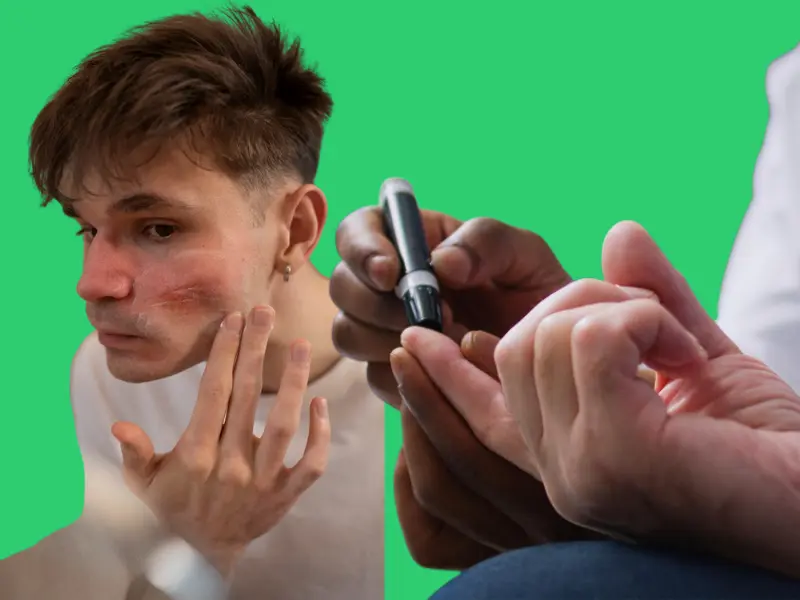Can Diabetics Use Sugar Scrubs?
Published: 11 Apr 2025
Skincare is essential for everyone, but diabetic skincare requires extra caution. Diabetes can lead to dry skin, slow healing, and a higher risk of infections, making certain skincare products risky. So, can diabetics use sugar scrubs? Yes, but with some extra precautions.
This article explores whether diabetics can use sugar scrubs, their risks, benefits, and expert recommendations. We’ll also cover safer alternatives and tips for keeping diabetic skin healthy and hydrated.
1- Can Diabetics Use Sugar Scrubs?
Using a sugar scrub when you have diabetes is like walking barefoot on a rough road; you need to be careful.
While sugar scrubs help remove dead skin, they can also cause tiny scratches or irritation, which may lead to infections, especially if you have cuts, wounds, or neuropathy (nerve damage that reduces sensation).

However, a gentle sugar scrub can still be safe if your skin is healthy and well-moisturised, just like wearing protective shoes on that rough road.
Use mild scrubs, avoid broken skin, and always follow up with a good moisturiser to keep your skin barrier strong and prevent dryness.
2- Why Skin Care is Different for Diabetics
Taking care of your skin when you have diabetes is like maintaining a delicate fabric. Any small tear can quickly worsen if not handled properly.

- Diabetics face a higher risk of infections because their wounds heal more slowly, making even minor cuts or cracks potential entry points for bacteria. (1)
- High blood sugar weakens the skin’s natural defences, leading to dryness, cracks, and an increased risk of infections.
- Neuropathy (nerve damage) further complicates things by reducing pain sensation, meaning a person may not even notice an injury until it becomes serious.
For example, a small scratch on a diabetic foot can turn into a deep ulcer if left untreated. That’s why diabetics need to be extra cautious with their skincare routine.
If you’re careful about skincare, you’re probably also cautious with eye care. Can contact lenses be safe for diabetics?
3- Pros & Cons of Sugar Scrubs for Diabetics
Using a sugar scrub as a diabetic is like walking a fine line. It can be beneficial, but only if used with care.
| ✅ Potential Benefits: |
|---|
|
| ❌ Risks & Concerns: |
|---|

Diabetics who choose to use sugar scrubs should be extra gentle and always follow up with a moisturizer to protect the skin barrier. |
Sensitive skin and nerves? You might want to learn about using heated pads safely when living with diabetes.
4- How to Use Sugar Scrubs Safely (If You Choose to Use Them)
If you decide to use a sugar scrub, follow these safety tips:
🔹 Pick a mild sugar scrub with fine sugar particles to avoid harsh abrasion.
🔹 Avoid scented scrubs—fragrances can irritate sensitive skin.
🔹 Use gentle circular motions rather than aggressive scrubbing to prevent microtears.
🔹 Limit use to once a week to prevent over-exfoliation and dryness.
🔹 Always moisturize afterwards to restore hydration and strengthen the skin barrier.
🔹 Never apply on feet or open wounds, as this increases the risk of infection.
Instead of scrubbing hard, imagine you’re polishing a delicate glass. A gentle 30-second massage is enough to exfoliate without harming your skin.
5- Best Sugar Scrub Alternatives for Diabetics
If sugar scrubs seem too harsh, don’t worry. There are gentler options that can keep your skin smooth without the risk. Think of these like soft sponges instead of rough brushes—they exfoliate without causing harm.
- Oatmeal Scrubs – Naturally soothing and perfect for sensitive skin.
- Hyaluronic Acid Serums – Hydrate deeply without the need for exfoliation.
- Lactic Acid (Mild AHA Exfoliant) – Gently dissolves dead skin cells without scrubbing.
- Aloe Vera & Honey Mix – Soothes irritation while promoting skin healing.
- Soft Washcloth with Warm Water – A simple yet effective way to remove dead skin.
Tip: Always check skincare labels for “fragrance-free” and “hypoallergenic” to reduce the risk of irritation!
6- Final Verdict: Should Diabetics Use Sugar Scrubs?
It depends on your skin’s condition. If your skin is healthy, unbroken, and not affected by neuropathy, you can use a mild sugar scrub occasionally, but with caution.
Always use gentle motions, rinse thoroughly, and moisturise afterwards to keep your skin protected.
However, if you have dry, sensitive skin, slow-healing wounds, or a history of infections, it’s best to skip sugar scrubs and choose safer exfoliation methods like oatmeal scrubs or lactic acid.
Your skin’s health comes first, so always prioritise gentle care over deep exfoliation!
7- Final Tip
Always consult a dermatologist before adding new skincare products to your routine, especially if you have diabetes-related skin issues like dryness, infections, or slow healing. A professional can recommend the safest options tailored to your skin’s needs, ensuring you stay protected and healthy.
8- FAQs
Yes, but only if your skin is healthy and not overly dry or sensitive. Use a fine sugar scrub gently and always moisturise after. Avoid harsh scrubbing to prevent irritation.
Diabetics heal more slowly and are at a higher risk of infections. Scrubbing too hard can cause tiny skin tears, allowing bacteria to enter. If sugar residues remain, they might encourage bacterial growth.
No, it’s not recommended. Diabetic feet are prone to nerve damage (neuropathy) and slow healing. A small cut can turn into a serious infection. Instead, use a moisturising foot cream or a soft washcloth for exfoliation.
Not necessarily. While homemade scrubs avoid chemicals, they still contain sugar, which can be too harsh on diabetic skin. Instead, try oatmeal scrubs or mild lactic acid exfoliants for a gentler option.
Choose fragrance-free, hypoallergenic, and gentle formulas. Look for fine exfoliants like oatmeal, lactic acid, or soft washcloths instead of sugar or salt scrubs. Always moisturize after exfoliating to prevent dryness.
Once a week or less to avoid over-exfoliation. Diabetic skin needs extra hydration, so always follow up with a moisturizer after exfoliating. If irritation occurs, stop immediately.
Even tiny cuts can be risky due to slow healing. Clean the area immediately with mild soap and water, apply antiseptic, and monitor for signs of infection (redness, swelling, pus). If it worsens, seek medical help.
They remove dead skin, but they can also make dryness worse. Gentle hydration (like aloe vera, hyaluronic acid, or fragrance-free moisturizers) is a better way to treat diabetic dry skin.
Yes, but it must be done safely. Gentle exfoliation removes dead skin and allows skincare products to absorb better. However, moisturizing is even more important for diabetic skin health.
Use hydrating products like hyaluronic acid, lactic acid, and oatmeal scrubs. Avoid anything too rough and always moisturize daily to prevent dryness and cracks. Keeping blood sugar levels stable also helps maintain healthy skin.
References
At MedicaWire, all medically sensitive content is reviewed by licensed healthcare professionals. Our team ensures that the information you read is accurate, up-to-date, and based on trusted medical sources.
Learn how we maintain high standards by reading our Editorial Policy.
📚 Sources
- American Diabetes Association. (2021). Skin Complications.
This resource outlines common skin issues faced by individuals with diabetes and offers guidance on prevention and care.
https://www.diabetes.org/diabetes/complications/skin-complications - National Institute of Diabetes and Digestive and Kidney Diseases (NIDDK). (2017). Skin Problems and Diabetes.
This publication discusses various skin conditions associated with diabetes and emphasizes the importance of proper skincare routines.
https://www.niddk.nih.gov/health-information/diabetes/overview/preventing-problems/skin-problems - American Academy of Dermatology Association. (n.d.). How to care for your skin if you have diabetes.
This article provides dermatologist-approved skincare tips for individuals managing diabetes, focusing on maintaining skin health and preventing complications.
https://www.aad.org/public/diseases/a-z/diabetes-skin-care
ℹ️ Our Promise
MedicaWire follows strict sourcing guidelines and only references peer-reviewed studies, academic institutions, and reputable medical associations. We update content regularly to reflect new health information.

- Be Respectful
- Stay Relevant
- Stay Positive
- True Feedback
- Encourage Discussion
- Avoid Spamming
- No Fake News
- Don't Copy-Paste
- No Personal Attacks



- Be Respectful
- Stay Relevant
- Stay Positive
- True Feedback
- Encourage Discussion
- Avoid Spamming
- No Fake News
- Don't Copy-Paste
- No Personal Attacks



